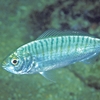General Description
Iridescent blue-green above, silvery-golden below with small dark spots on sides, dorsal fin dark green to deep blue; other fins usually yellow to orange. To 2 m.
Biology
This species often aggregates beneath floating debris, Sargassum, or around structures such as oil rigs. It is an important commercial and recreational species and is considered excellent eating. It is a very fast swimmer and feeds mostly on smaller pelagic fishes such as flyingfishes and garfishes.
Habitat
A pelagic open-ocean species found in tropical and warm temperate waters, rarely ventures inshore.
Open water
Distribution guide
Worldwide.
Species Group
Depth
Shallow (1-30 m)
Deep ( > 30 m)
Max Size
2 m
Commercial Species
No
Global Dispersal
Recorded in Australia
Conservation Status
- DSE Advisory List : Not listed
- EPBC Act 1999 : Not listed
- IUCN Red List : Least Concern





